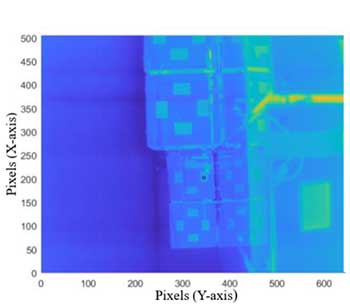A significant portion of radioactive material stored at the Sellafield site in Cumbria is classified as intermediate level waste (ILW). This means that it includes radioactive, contaminated materials from reactor decommissioning and radiation therapy, and requires long-term management.
The primary container for intermediate level waste storage is the ‘3 m3 box’. This consists of an inner skip, containing the immersed nuclear waste, and an outer 3 m3 box, with vents to allow for gas release and cooling. This ILW container is denoted the 3 m3 box to follow common use at Sellafield Ltd.
Monitoring the temperature of the exterior of the boxes within their planned storage facility is vital to confirm the waste and package behaviour, e.g., to identify any anomalously higher temperature packages which may indicate those 3 m3 boxes contain more heat generating material, and to track the thermal evolution of the 3 m3 boxes over time.
An ’off the shelf’ thermal imager would be able to provide some information about the condition of 3 m3 boxes in storage, but in order to determine an estimate of the internal temperature, specialist measurements and corrections are required.

NPL tested various approaches for determining internal storage temperature.
NPL produced a 1:10 mock-up of the 3 m3 box facility which used well characterised materials, with known surface emissivity, and had environmental controls (see image – a thermal image of the mock-up of several target boxes heated to an elevated temperature). This enabled NPL to test various approaches for determining internal 3 m3 box temperatures.
The first key challenge of the 3 m3 box storage facility is the changing environmental temperature throughout the year. To account for this, NPL used their calibration standards to calibrate an off the shelf thermal imager to a low traceable uncertainty across a range of operating temperatures. The relationship between the internal skip and outer box surface temperature was then characterised at different environment temperatures to enable the tracking of internal changes by measuring the outer box.
The second key challenge was the relatively high infra-red reflectivity of the surface of the 3 m3 boxes. Thermal imaging relies on measuring the infra-red energy that an object gives off, which is related to its temperature. To correct the data, the reflectivity at the relevant wavelengths of the boxes was measured. The correction to determine the surface temperature was performed on a test box by calculating the proportion of infra-red light measured for a given box area that was reflected ambient thermal radiation from the box surface. This reflected component could then be removed before calculating the surface temperature of the box.
The two investigations were combined, resulting in a more accurate temperature measurement for Sellafield. Temperature monitoring of the exterior of the outer 3 m3 boxes using a calibrated thermal imager within the storage environment will enable the identification of any boxes that are showing unusual behaviour or an increase in temperature over time. These measurements will enable the safe storage and accurate monitoring of 3 m3 boxes containing intermediate level nuclear waste on an on-going basis.
Find out more about NPL’s nuclear metrology research
Find out more about NPL’s surface technology research
Find out more about NPL’s temperature & humidity research
Find out more about NPL’s work in with energy & utilities industry
Find out more about NPL’s work within the environment national challenge